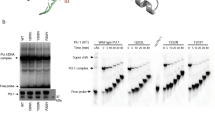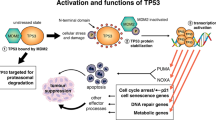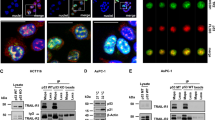Abstract
We earlier reported that PU.1 was downregulated in myeloma cell lines and myeloma cells in a subset of myeloma patients, and that conditional PU.1 expression in PU.1-negative myeloma cell lines, U266 and KMS12PE, induced growth arrest and apoptosis. To elucidate the molecular mechanisms of the growth arrest and apoptosis, we performed DNA microarray analyses to compare the difference in gene expression before and after PU.1 induction in U266 cells. Among cell cycle-related genes, cyclin A2, cyclin B1, CDK2 and CDK4 were downregulated and p21 was upregulated, although among apoptosis-related genes, tumor necrosis factor (TNF)-related apoptosis inducing ligand (TRAIL) was found highly upregulated. When TRAIL was knocked down by small interference RNAs, apoptosis of PU-1-expressing cells was inhibited, suggesting that TRAIL has a critical role in PU.1-induced apoptosis in both U266 and KMS12PE myeloma cells. In both U266 and KMS12PE cells expressing PU.1, PU.1 directly bound to a region 30 bp downstream of the transcription start site of the TRAIL gene. Upregulation of PU.1-induced transactivation of the TRAIL promoter in reporter assays, and disruption of the PU.1-binding site in the TRAIL promoter eliminated this transactivation. Therefore, we conclude that PU.1 is capable of inducing apoptosis in certain myeloma cells by direct transactivation of TRAIL.
This is a preview of subscription content, access via your institution
Access options
Subscribe to this journal
Receive 50 print issues and online access
$259.00 per year
only $5.18 per issue
Buy this article
- Purchase on SpringerLink
- Instant access to full article PDF
Prices may be subject to local taxes which are calculated during checkout






Similar content being viewed by others
References
Amaravadi L, Klemsz MJ . (1999). DNA methylation and chromatin structure regulate PU.1 expression. DNA Cell Biol 18: 875–884.
Attal M, Harousseau JL, Facon T, Guilhot F, Doyen C, Fuzibet JG et al. (2003). Single versus double autologous stem-cell transplantation for multiple myeloma. N Engl J Med 349: 2495–2502.
Coccia EM, Del Russo N, Stellacci E, Orsatti R, Benedetti E, Marziali G et al. (1999). Activation and repression of the 2-5A synthetase and p21 gene promoters by IRF-1 and IRF-2. Oncogene 18: 2129–2137.
de Veer MJ, Sim H, Whisstock JC, Devenish RJ, Ralph SJ . (1998). IFI60/ISG60/IFIT4, a new member of the human IFI54/IFIT2 family of interferon-stimulated genes. Genomics 54: 267–277.
Gazitt Y . (1999). TRAIL is a potent inducer of apoptosis in myeloma cells derived from multiple myeloma patients and is not cytotoxic to hematopoietic stem cells. Leukemia 13: 1817–1824.
Hideshima T, Richardson P, Anderson KC . (2003). Novel therapeutic approaches for multiple myeloma. Immunol Rev 194: 164–176.
Hideshima T, Richardson P, Chauhan D, Palombella VJ, Elliott PJ, Adams J et al. (2001). The proteasome inhibitor PS-341 inhibits growth, induces apoptosis, and overcomes drug resistance in human multiple myeloma cells. Cancer Res 61: 3071–3076.
Huang G, Zhang P, Hirai H, Elf S, Yan X, Chen Z et al. (2008). PU.1 is a major downstream target of AML1 (RUNX1) in adult mouse hematopoiesis. Nat Genet 40: 51–60.
Iida S, Rao PH, Butler M, Corradini P, Boccadoro M, Klein B et al. (1997). Deregulation of MUM1/IRF4 by chromosomal translocation in multiple myeloma. Nat Genet 17: 226–230.
Insinga A, Monestiroli S, Ronzoni S, Gelmetti V, Marchesi F, Viale A et al. (2005). Inhibitors of histone deacetylases induce tumor-selective apoptosis through activation of the death receptor pathway. Nat Med 11: 71–76.
Kirshner JR, Karpova AY, Kops M, Howley PM . (2005). Identification of TRAIL as an interferon regulatory factor 3 transcriptional target. J Virol 79: 9320–9324.
Klein U, Casola S, Cattoretti G, Shen Q, Lia M, Mo T et al. (2006). Transcription factor IRF4 controls plasma cell differentiation and class-switch recombination. Nat Immunol 7: 773–782.
Klemsz MJ, McKercher SR, Celada A, Van Beveren C, Maki RA . (1990). The macrophage and B cell-specific transcription factor PU.1 is related to the ets oncogene. Cell 61: 113–124.
Li Y, Okuno Y, Zhang P, Radomska HS, Chen H, Iwasaki H et al. (2001). Regulation of the PU.1 gene by distal elements. Blood 98: 2958–2965.
Loots GG, Locksley RM, Blankespoor CM, Wang ZE, Miller W, Rubin EM et al. (2000). Identification of a coordinate regulator of interleukins 4, 13, and 5 by cross-species sequence comparisons [see comments]. Science 288: 136–140.
Mariani SM, Matiba B, Armandola EA, Krammer PH . (1997). Interleukin 1 beta-converting enzyme related proteases/caspases are involved in TRAIL-induced apoptosis of myeloma and leukemia cells. J Cell Biol 137: 221–229.
McKercher SR, Torbett BE, Anderson KL, Henkel GW, Vestal DJ, Baribault H et al. (1996). Targeted disruption of the PU.1 gene results in multiple hematopoietic abnormalities. Embo J 15: 5647–5658.
Mitsiades CS, Treon SP, Mitsiades N, Shima Y, Richardson P, Schlossman R et al. (2001). TRAIL/Apo2 L ligand selectively induces apoptosis and overcomes drug resistance in multiple myeloma: therapeutic applications. Blood 98: 795–804.
Mitsiades N, Mitsiades CS, Poulaki V, Anderson KC, Treon SP . (2002). Intracellular regulation of tumor necrosis factor-related apoptosis-inducing ligand-induced apoptosis in human multiple myeloma cells. Blood 99: 2162–2171.
Moreau-Gachelin F, Tavitian A, Tambourin P . (1988). Spi-1 is a putative oncogene in virally induced murine erythroleukaemias. Nature 331: 277–280.
Nebbioso A, Clarke N, Voltz E, Germain E, Ambrosino C, Bontempo P et al. (2005). Tumor-selective action of HDAC inhibitors involves TRAIL induction in acute myeloid leukemia cells. Nat Med 11: 77–84.
Okuno Y, Huang G, Rosenbauer F, Evans EK, Radomska HS, Iwasaki H et al. (2005). Potential autoregulation of transcription factor PU.1 by an upstream regulatory element. Mol Cell Biol 25: 2832–2845.
Okuno Y, Huettner CS, Radomska HS, Petkova V, Iwasaki H, Akashi K et al. (2002a). Distal elements are critical for human CD34 expression in vivo. Blood 100: 4420–4426.
Okuno Y, Iwasaki H, Huettner CS, Radomska HS, Gonzalez DA, Tenen DG et al. (2002b). Differential regulation of the human and murine CD34 genes in hematopoietic stem cells. Proc Natl Acad Sci USA 99: 6246–6251.
Pahl HL, Scheibe RJ, Zhang DE, Chen HM, Galson DL, Maki RA et al. (1993). The proto-oncogene PU.1 regulates expression of the myeloid-specific CD11b promoter. J Biol Chem 268: 5014–5020.
Radomska HS, Gonzalez DA, Okuno Y, Iwasaki H, Nagy A, Akashi K et al. (2002). Transgenic targeting with regulatory elements of the human CD34 gene. Blood 100: 4410–4419.
Rosenbauer F, Owens BM, Yu L, Tumang JR, Steidl U, Kutok JL et al. (2006). Lymphoid cell growth and transformation are suppressed by a key regulatory element of the gene encoding PU.1. Nat Genet 38: 27–37.
Rosenbauer F, Wagner K, Kutok JL, Iwasaki H, Le Beau MM, Okuno Y et al. (2004). Acute myeloid leukemia induced by graded reduction of a lineage-specific transcription factor, PU.1. Nat Genet 36: 624–630.
Shaffer AL, Emre NC, Lamy L, Ngo VN, Wright G, Xiao W et al. (2008). IRF4 addiction in multiple myeloma. Nature 454: 226–231.
Singhal S, Mehta J, Desikan R, Ayers D, Roberson P, Eddlemon P et al. (1999). Antitumor activity of thalidomide in refractory multiple myeloma. N Engl J Med 341: 1565–1571.
Tatetsu H, Ueno S, Hata H, Yamada Y, Takeya M, Mitsuya H et al. (2007). Down-regulation of PU.1 by methylation of distal regulatory elements and the promoter is required for myeloma cell growth. Cancer Res 67: 5328–5336.
Tenen DG . (2003). Disruption of differentiation in human cancer: AML shows the way. Nat Rev Cancer 3: 89–101.
Yu W, Misulovin Z, Suh H, Hardy RR, Jankovic M, Yannoutsos N et al. (1999). Coordinate regulation of RAG1 and RAG2 by cell type-specific DNA elements 5′ of RAG2. Science 285: 1080–1084.
Acknowledgements
This work was supported by The Award in Aki's Memory from The International Myeloma Foundation Japan (YO) and grants from the Ministry of Education, Culture, Sports, Science and Technology of Japan.
Author information
Authors and Affiliations
Corresponding author
Additional information
Supplementary Information accompanies the paper on the Oncogene website (http://www.nature.com/onc)
Rights and permissions
About this article
Cite this article
Ueno, S., Tatetsu, H., Hata, H. et al. PU.1 induces apoptosis in myeloma cells through direct transactivation of TRAIL. Oncogene 28, 4116–4125 (2009). https://doi.org/10.1038/onc.2009.263
Received:
Revised:
Accepted:
Published:
Issue date:
DOI: https://doi.org/10.1038/onc.2009.263
Keywords
This article is cited by
-
PU.1 supports TRAIL-induced cell death by inhibiting NF-κB-mediated cell survival and inducing DR5 expression
Cell Death & Differentiation (2017)
-
Restoring PU.1 induces apoptosis and modulates viral transactivation via interferon-stimulated genes in primary effusion lymphoma
Oncogene (2017)
-
PU.1 acts as tumor suppressor for myeloma cells through direct transcriptional repression of IRF4
Oncogene (2017)
-
NF-κB/STAT5/miR-155 network targets PU.1 in FLT3-ITD-driven acute myeloid leukemia
Leukemia (2015)
-
The anti-apoptotic gene BCL2A1 is a novel transcriptional target of PU.1
Leukemia (2010)



